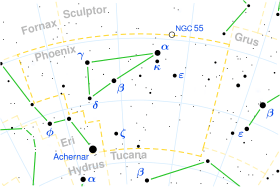Iota Phoenicis
| Observation data Epoch J2000 Equinox J2000 | |
|---|---|
| Constellation | Phoenix |
| Right ascension | 23h 35m 04.56417s[1] |
| Declination | −42° 36′ 54.2709″[1] |
| Apparent magnitude (V) | 4.71[2] (4.70 - 4.75)[3] |
| Characteristics | |
| Spectral type | A2VpSrCrEu[3] |
| U−B color index | +0.07[2] |
| B−V color index | +0.08[2] |
| Variable type | ACV[3] |
| Astrometry | |
| Radial velocity (Rv) | +19.40[4] km/s |
| Proper motion (μ) | RA: +42.31[1] mas/yr Dec.: +10.67[1] mas/yr |
| Parallax (π) | 13.11 ± 0.53[1] mas |
| Distance | 250 ± 10 ly (76 ± 3 pc) |
| Absolute magnitude (MV) | 0.28[5] |
| Details | |
| Mass | 2.23[6] M☉ |
| Luminosity | 67.41[5] L☉ |
| Surface gravity (log g) | 3.89[6] cgs |
| Temperature | 8,911[6] K |
| Metallicity [Fe/H] | -0.01[7] dex |
| Rotational velocity (v sin i) | 23[6] km/s |
| Other designations | |
| Database references | |
| SIMBAD | data |
Iota Phoenicis (ι Phe) is a class A2V[3] (white main-sequence) star in the constellation Phoenix. An Alpha² Canum Venaticorum variable, its apparent magnitude varies from 4.70 to 4.75 of a period of about 12.5 days[3] and it is approximately 249 light years away based on parallax.[1]
It also has one companion, at a separation of 6.7" and a magnitude about 12.8.[8]
References
- 1 2 3 4 5 6 Van Leeuwen, F. (2007). "Validation of the new Hipparcos reduction". Astronomy and Astrophysics. 474 (2): 653. arXiv:0708.1752
 . Bibcode:2007A&A...474..653V. doi:10.1051/0004-6361:20078357. Vizier catalog entry
. Bibcode:2007A&A...474..653V. doi:10.1051/0004-6361:20078357. Vizier catalog entry - 1 2 3 Ducati, J. R. (2002). "VizieR Online Data Catalog: Catalogue of Stellar Photometry in Johnson's 11-color system". CDS/ADC Collection of Electronic Catalogues. 2237. Bibcode:2002yCat.2237....0D.
- 1 2 3 4 5 Samus, N. N.; Durlevich, O. V.; et al. (2009). "VizieR Online Data Catalog: General Catalogue of Variable Stars (Samus+ 2007-2013)". VizieR On-line Data Catalog: B/gcvs. Originally published in: 2009yCat....102025S. 1. Bibcode:2009yCat....1.2025S. Vizier catalog entry
- ↑ Wilson, R. E. (1953). General Catalogue of Stellar Radial Velocities. Carnegie Institution of Washington. Bibcode:1953GCRV..C......0W. LCCN 54001336.
- 1 2 Anderson, E.; Francis, Ch. (2012). "XHIP: An extended hipparcos compilation". Astronomy Letters. 38 (5): 331. arXiv:1108.4971
 . Bibcode:2012AstL...38..331A. doi:10.1134/S1063773712050015. Vizier catalog entry
. Bibcode:2012AstL...38..331A. doi:10.1134/S1063773712050015. Vizier catalog entry - 1 2 3 4 David, Trevor J.; Hillenbrand, Lynne A. (2015). "The Ages of Early-Type Stars: Strömgren Photometric Methods Calibrated, Validated, Tested, and Applied to Hosts and Prospective Hosts of Directly Imaged Exoplanets". The Astrophysical Journal. 804 (2): 146. arXiv:1501.03154
 . Bibcode:2015ApJ...804..146D. doi:10.1088/0004-637X/804/2/146. Vizier catalog entry
. Bibcode:2015ApJ...804..146D. doi:10.1088/0004-637X/804/2/146. Vizier catalog entry - ↑ Gontcharov, G. A. (2012). "Dependence of kinematics on the age of stars in the solar neighborhood". Astronomy Letters. 38 (12): 771. arXiv:1606.08814
 . Bibcode:2012AstL...38..771G. doi:10.1134/S1063773712120031. Vizier catalog entry
. Bibcode:2012AstL...38..771G. doi:10.1134/S1063773712120031. Vizier catalog entry - ↑ Eggleton, P. P.; Tokovinin, A. A. (2008). "A catalogue of multiplicity among bright stellar systems". Monthly Notices of the Royal Astronomical Society. 389 (2): 869. arXiv:0806.2878
 . Bibcode:2008MNRAS.389..869E. doi:10.1111/j.1365-2966.2008.13596.x. Vizier catalog entry
. Bibcode:2008MNRAS.389..869E. doi:10.1111/j.1365-2966.2008.13596.x. Vizier catalog entry
This article is issued from Wikipedia - version of the 10/29/2016. The text is available under the Creative Commons Attribution/Share Alike but additional terms may apply for the media files.
